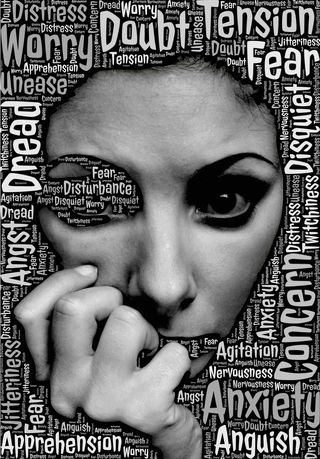Anxiety
Ancient Brains and Modern Anxiety
Why anxiety comes naturally, and what to do about it.
Posted March 29, 2019
There’s no evolutionary reward for being relaxed in the face of danger. On the contrary, being suspicious of the merest hint of danger, and reacting vigorously to every possible threat, could be life-saving.
...The sound of a twig cracking?...could be a stealth lion attack!
...The hint of a moving shadow in our peripheral vision?...could be a rattlesnake!
...An unusual footprint?...could be an unknown predator!
Although most of us today inhabit a world where there are few immediate threats to life, our modern brains retain this primitive ‘threat detection’ system which is constantly scanning the world for danger and problems that require our attention.
We all necessarily see the world through the filter of our own biases, expectations and focus because we can’t attend to everything.
However, stress of any kind pushes us into high alert which fuels our underlying tendency to both see the worst, and to over-react when our fears seem to be realized. If we are currently worried or sad—or if we’ve developed lifelong "negative thinking" habits such as those associated with anxiety and depression—we are almost certainly regularly seeing ourselves, others and/or the world as more threatening, negative or lacking than they really are.
This has the unfortunate consequence that when we are struggling, we are often the least objective about what we are capable of, and what other people and the world can offer us. It doesn’t need spelling out why this is bad for our mental health and life choices.
We don’t see the world as it is, but as we are. And the truth is we are prone to look on the dark side. Learning to manage our ancient survival tendency to see possible threats everywhere can reduce much of our modern angst, anxiety, and depression.
Imagined threats and real ones affect us in the same way
Our threat-detection system depends on an initial, super-quick assessment of danger by a simple, ancient, emotional bit of our brain. To have the best chance at keeping us safe, it responds automatically without wasting much time on a full analysis of the situation or on any ‘top-down’ rational thinking, to launch automatic defensive behaviors such as fight or flight.

Thus when a ‘threat’ decision is made, we are not in full possession of information about the current situation. We take in enough information just to register the possibility of danger, but not how likely it is or how serious it might be. Our threat-detection system is looking for any possible match at all in the current situation—no matter how tenuous. What we see as a possible threat is based on a record of past experiences, such as the time a tiger ate my neighbor.
In other words, whilst our response is governed in part by what we see out in the world that might harm us, it is mainly driven by our store of expectations and fears based on interpretations of past experiences that tell us what to look out, and what is a threat to us and our view of ourselves. Thus if this "threat" store is overactive or overfull, we will continually be under stress as the world will appear constantly threatening.
For good evolutionary reasons, our automatic responses are largely the same irrespective of whether there is a clear objective threat in the environment - an angry saber-toothed tiger - or just the hint of a shadow that might just possibly be a tiger.
But crucially, our stress system will also respond the same if we perceive a threat even if it is entirely down to our interpretation or expectation or beliefs. If we currently believe that tigers eat sandwiches in addition to humans, we may react with fear to a trail of breadcrumbs.
In the modern world, our life is rarely in danger, but we can all be threatened by challenges to our status, how we are viewed by others, whether we are good enough, harm to those we love, or whether care or attention from others might be withdrawn, for example.

For each of us, it is our personal past experiences, our specific interpretation of them, and our idiosyncratic beliefs and expectations that determine what specific situations we individually see as a threat (beyond the obvious pouncing tigers, of course).
For example, if we are preoccupied with the fear we are not good enough and that we might get fired, we may interpret an odd look from our boss as something to be worried about. In fact, our boss may merely have something in their eye, be thinking about something unconnected to us, or may even be impressed by something we’ve done. If we are anxious about a relationship, we may worry that if our partner is ten minutes late to meet us it means they don’t care, when in fact their bus was unavoidably delayed.
When stressed, our thinking tends to back up our fears
Our ’thinking’ brain does not kick in to work out what has happened and what to do about it until after a threat signal has already triggered a physiological response and possibly some immediate action (such as fight, flight or freeze, where appropriate).
Unfortunately, at this point, the "big picture" rational bits of the brain tend to be switched off, as they are not central to immediate life-preservation. However, as noted above, when stressed, our store of past experiences and beliefs about danger is easily available.
Thus when we are trying to understand our distress at the moment, we continually fall back on our most readily available habitual thoughts and fears as an explanation, even though they may not really fit the current facts. So we find ourselves thinking that here’s more evidence that "I’ll never be good enough," "I’m going to get fired," "She’s going to leave me," even though all that happened is the boss made a funny expression, or our partner was ten minutes late.
If we are not careful, our mind then races away ruminating about the problems it has ‘identified’, and trying to work out how to fix them, even though they may have very little to do with what is happening at the moment. "Am I going to be able to pay the mortgage once I’ve been fired?" "Should I leave her before she dumps me?" At some level, these fears are felt as facts (imagined threats and real ones affect us in the same way, remember?) which perpetuates the stress cycle.
This is, of course, the basis of anxiety: A fear of something that hasn’t yet, that might never happen, that I am scared I can’t handle. These easily-activated thought patterns in fact merely reflect our triggers and deep-seated fears, but feel so very real at the moment.
Note that this is the opposite way around from how we usually understand our thoughts. We are not (initially) stressed because of what we are consciously thinking, but because of an unconscious, automatic, biased assessment of a situation—with our thoughts filling in an explanation after the fact.
Of course, our anxious thoughts can then themselves lead to more stress as we beat ourselves up, which can then refuel the cycle.
It is very easy for us to see the worst and act accordingly, often sabotaging even the best of situations.
What can I do about it?
Awareness is the key to changing any mental habit. Typically, our unhelpful mental habits are so normal to us that we often don’t notice until we’ve been stuck in baseless, negative loops of thought for hours - if we notice at all.
One very useful trick is to start tuning in to the bodily sensations associated with stresses and anxiety that almost always precede unhelpful habitual thoughts. These physical signs are related to the activation of the sympathetic nervous system that prepares us for action once a threat has been detected.
Using physical signs as cues gives us a much better chance of intercepting habitual negative thoughts before they have time to run away with us, and it reduces the time spent immersed in negative and dark thoughts.
You may recognize some of the following common signs of stress and anxiety: increased heart rate, increased muscle tension, tingling or numbness, hyperventilation, feeling weak, faint or dizzy, wanting to use the toilet more often, feeling sick, chest pain or tightness, tension headaches, feeling sweaty or feeling chilled, dry mouth. If you don't, watch out for them as you go through your day—you may have other symptoms too.
NB: It worth reminding ourselves this is a list of the symptoms of anxiety. Having these experiences is not a sign that there is anything wrong with us or the world. They are in fact a sign that our bodies are functioning normally.
If we notice these physical signs early enough, we can do two key things:
Firstly, we can learn to intercept before such feelings spiral into destructive thoughts.
Surprisingly often, an awareness of being stressed in the moment is sufficient to stop our usual habitual thoughts, but sometimes we can benefit from learning techniques that either displace those thoughts (e.g. count backward in 7s), or turn our attention away from them (e.g. focusing on what we can see, smell or hear).
It can also be helpful to identify the main "story lines" of our ruminations (e.g. "I’m not good enough," "She’ll abandon me"), so we can say to ourselves "Ok, I’ve heard you — you can stop now!"
Secondly, and just as importantly, by stepping back we can begin to get a more objective view of why the current situation feels threatening to us, and what our triggers are. Whilst it’s possible I’ve annoyed my boss which was why he looked at me strangely, there are other explanations. Start asking yourself the following sorts of questions:
- Can I come up with other alternative explanations for what is happening?
- What is the probability that my fearful assumptions are true?
- Can I identify the fears or beliefs that lead me to see this situation as a threat?
Self-awareness, understanding, and acceptance are the enemies of anxiety.
As ever, stress makes it harder to resist the pull of our habitual unhelpful thoughts, which themselves fuel further stress. Furthermore, chronic high levels of stress changes our "stress thermostat" so that we are tipped over into anxiety in more situations—at its worst, leading to a generalized anxiety disorder. We can also get into the habit of overreacting so that we react in a similar way to work stress or a traffic jam as we would to a charging tiger.
Managing stress and learning how to relax is thus also critical to managing our ancient anxious brains. You probably already know what works for you, and what practical steps you could take to make your life more manageable. Start them today!
We may also need to "re-calibrate" our stress responses so they don't fire so often, or react so strongly—try this article on cold water swimming for one drastic solution.




